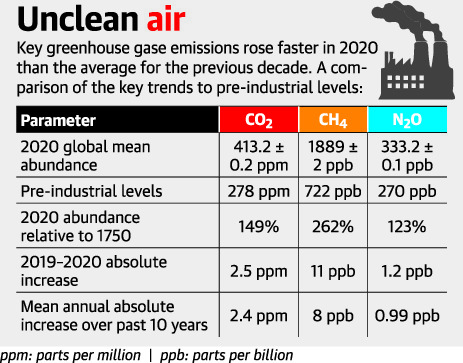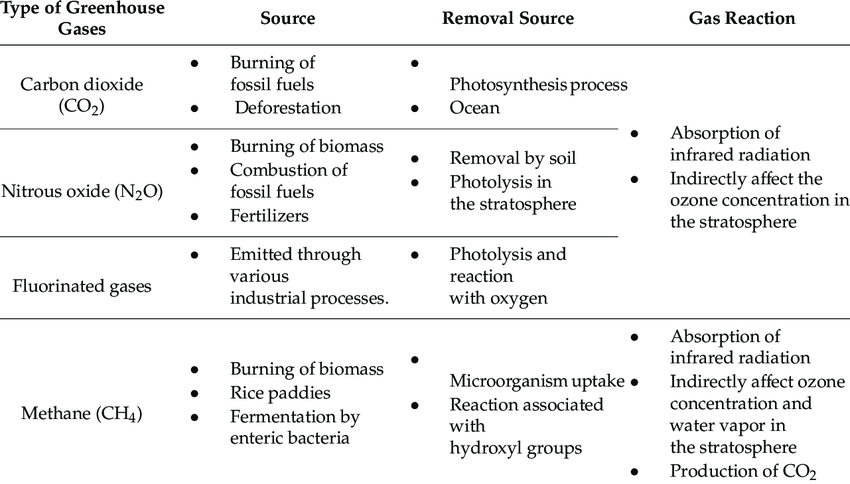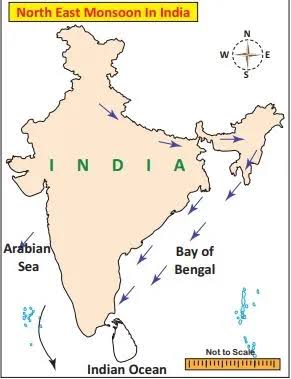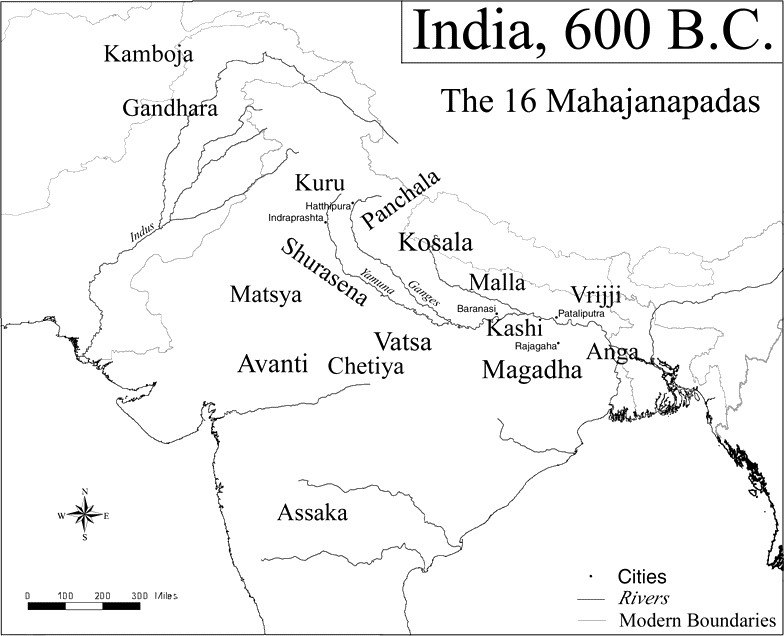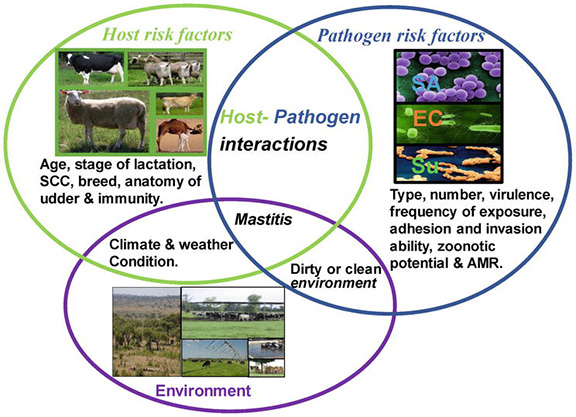Report on Heat-trapping Gases in the Atmosphere: WMO
Why in News
According to the World Meteorological Organization (WMO) Greenhouse Gas Bulletin, the abundance of heat-trapping greenhouse gases in the atmosphere once again reached a new record last year (2020), with the annual rate of increase above the 2011-2020 average.
- This is despite the approximately 5.6% drop in fossil fuel CO2 emissions in 2020 due to restrictions related to the pandemic.
- Earlier, the WMO released a report named United in Science 2021. WMO is a specialized agency of the United Nations for meteorology (weather and climate), operational hydrology and related geophysical sciences.
- The WMO Global Atmosphere Watch Programme coordinates systematic observations and analysis of greenhouse gases and other atmospheric constituents.
Key Points
- Data Analysis:
- Concentration of Carbon Dioxide (CO2), the most important greenhouse gas, reached 413.2 parts per million in 2020 and is 149% of the pre-industrial level.
- Many countries are now setting carbon neutral targets and it is hoped that COP26 (Climate Conference) will see a dramatic increase in commitments.
- Methane (CH4) is 262% and Nitrous Oxide (N2O) is 123% of the levels in 1750 when human activities started disrupting Earth’s natural equilibrium.
- The economic slowdown from Covid-19 did not have any distinguishable impact on the atmospheric levels of greenhouse gases and their growth rates, although there was a temporary decline in new emissions.
- From 1990 to 2020, radiative forcing – the warming effect on our climate - by long-lived greenhouse gases increased by 47%, with CO2 accounting for about 80% of this increase.
- The ability of land ecosystems and oceans to act as “sinks” may become less effective in future, thus reducing their ability to absorb carbon dioxide and act as a buffer against larger temperature increases.
- Concentration of Carbon Dioxide (CO2), the most important greenhouse gas, reached 413.2 parts per million in 2020 and is 149% of the pre-industrial level.
- Concerns:
- An increase in the temperature is expected by the end of this century far in excess of the Paris Agreement targets of 1.5 to 2 degrees Celsius above pre-industrial levels.
- Parts of the Amazon rainforest have gone from being a carbon sink that sucks carbon dioxide from the air to a source of CO2 due to deforestation and reduced humidity in the region.
- Given the long life of CO2, the temperature level already observed will persist for several decades even if emissions are rapidly reduced to net zero. Alongside rising temperatures, this means more weather extremes including intense heat and rainfall, ice melt, sea-level rise and ocean acidification, accompanied by far-reaching socioeconomic impacts.
- Related Indian Initiatives:
- Seaweed-Based Animal Feed to reduce methane emissions in bovine
- India Greenhouse Gas Program
- National Action Plan on Climate Change
- Bharat Stage-VI Norms
Climate Vulnerability Index
Why in News
Recently, a report titled “Mapping India’s Climate Vulnerability – A District-level Assessment” has been released by the Council on Energy, Environment and Water (CEEW) (not-for-profit policy research institution).
- The report has also launched the first-of-its-kind Climate Vulnerability Index.
- The index has analysed 640 districts in India and found that 463 of these are vulnerable to extreme floods, droughts and cyclones.
Key Points
- Affected States: 27 Indian states and Union territories are vulnerable to extreme climate events which often disrupt the local economy and displace weaker communities.
- The states of Assam, Andhra Pradesh, Maharashtra, Karnataka and Bihar are the most vulnerable to extreme climate events such as floods, droughts and cyclones in India.
- Magnitude of Impact of Climate Change: More than 80% of Indians live in districts vulnerable to climate risks.
- 17 of 20 people in the country are vulnerable to climate risks, out of which every five Indians live in areas that are extremely vulnerable.
- More than 45% of these districts have undergone “unsustainable landscape and infrastructure changes”.
- Low-level of Adaptability: More than 60% of Indian districts have medium to low adaptive capacity in handling extreme weather events.
- Role of Anthropogenic Activities: The anthropogenic activity has already made vulnerable districts become even more vulnerable to impacts of natural disasters. Some of the activities has led to:
- Loss of wetlands and loss in mangroves which would act as a natural barrier, making it more vulnerable.
- Landscape disruptions such as the disappearance of forest cover, over-construction, have led to degradation of natural ecosystems.
- Triggering Financial Crisis: Combating the rising frequency and scale of extreme climate events is fiscally draining for developing countries such as India.
- Investments in infrastructure such as housing, transport, and industries will be threatened by these events, especially along the coasts, adding that mounting weather-related insurance losses could trigger the next financial crisis.
Suggestions
- Decentralized Planning: Since most districts in India are highly vulnerable to extreme weather events, a district-wise climate action plan is required.
- The CEEW study also indicated that only 63% of Indian districts have a District Disaster Management Plan (DDMP).
- Policymakers, industry leaders and citizens must use the district-level analysis to make effective risk-informed decisions.
- Mobilizing Green Finance: With loss and damage rising exponentially due to the climate crisis, India must demand climate finance for adaptation-based climate actions at COP-26 (Climate Conference).
- At COP-26, developed countries must regain trust by delivering the USD 100 billion promised since 2009 and commit to stepping up climate finance over the coming decade.
- Further, India must collaborate with other countries to create a Global Resilience Reserve Fund, which could act as insurance against climate shocks.
- Climate Risk Identification: Finally, developing a Climate Risk Atlas for India would help policymakers to better identify and assess risks arising from extreme climate events.
- Climate-proofing of physical and ecosystem infrastructures should also now become a national imperative.
- Institutional Setup: India must create a new Climate Risk Commission to coordinate the environmental de-risking mission.
- Enhanced climate finance can also support India-led global agencies like the Coalition for Disaster Resilient Infrastructure (CDRI) to further mainstream climate actions.
Other Indices Related to Climate Change
- Climate Change Performance Index (Germanwatch, the New Climate Institute and the Climate Action Network)
- Global Climate Risk Index 2021 (Germanwatch)
- Environmental Performance Index (Yale University and Columbia University in collaboration with the World Economic Forum).
- Hunger Hotspots Report (FAO and WFP)
- Children’s Climate Risk Index (UNICEF)
Widespread Northeast Monsoon: IMD
Why in News
According to the India Meteorological Department (IMD), the northeast monsoon, which makes up for most of Tamil Nadu's annual rainfall, has arrived.
- Normally, the northeast monsoon sets in around 20th October.
- The prolonged southwest monsoon has led to the delay in onset this year.
Key Points
- About the Monsoon:
- Generally, across the world, the monsoons are experienced in the tropical area roughly between 20° N and 20° S.
- The climate of India is described as the ‘monsoon’ type.
- In Asia, this type of climate is found mainly in the south and the southeast.
- Rainfall in India:
- Southwest monsoon: About 75% of the country’s annual rainfall is received from the Southwest monsoon between June and September.
- Northeast monsoon: It occurs during October to December.
- NorthEast Monsoon (NEM):
- Winter Monsoon: It is a comparatively small-scale monsoon, which is confined to the Southern peninsula.
- It is called the winter monsoon.
- Factors Behind Northeast Monsoon:
- Change in Wind pattern: After the complete withdrawal of the Southwest monsoon from the country takes place by mid-October, the wind pattern rapidly changes from the south-westerly to the north-easterly direction.
- Cyclonic Activities: The period after the Southwest monsoon season, from October to December, is the peak time for cyclonic activity in the North Indian Ocean region covering the Arabian Sea and the Bay of Bengal.
- The winds associated with the formation of low pressure systems, depressions, or cyclones influence this monsoon, and therefore, the rainfall.
- Global Climate Parameters: The NEM rainfall is influenced by global climate parameters such as ENSO (El Nino/La Nina & Southern Oscillation Index - SOI), Indian Ocean Dipole (IOD) and Madden-Julian Oscillation (MJO).
- El Nino, positive IOD and MJO in phase 2-4 with amplitude greater than one are generally associated with good NEM rainfall.
- Also, La Nina & positive SOI during the second half of the season is also favourable for good NEM activity.
- Regions Associated:
- Tamil Nadu, Puducherry, Karaikal, Yanam, coastal Andhra Pradesh, Kerala, north interior Karnataka, Mahe and Lakshadweep.
- Tamil Nadu records about 48% of its annual rainfall during these months, making it the key factor for undertaking agricultural activities and reservoir management in the state.
- Winter Monsoon: It is a comparatively small-scale monsoon, which is confined to the Southern peninsula.
Traffic Management Framework for Drones
Why in News
Recently, the Ministry of Civil Aviation has notified a traffic management policy framework for drones. This could be regarded as the first step towards allowing Beyond Visual Line of Sight (BVLOS) drone operations.
Key Points
- Traffic Management Framework: The rules envisages private, third-party service providers for ensuring safe operations.
- Under the framework, Unmanned Traffic Management Service Providers (UTMSP) will extend automated, algorithm-driven software services instead of voice communication as in the traditional Air Traffic Management (ATM) systems.
- Scope of Regulation: All drones (except nano drones operating in the green zone) shall be required to share their real-time location through the network to the Centre.
- Law enforcement and security agencies will also have access to some information in the UTM ecosystem on a need-to-know basis.
- Responsibility of UTMSP: They will primarily be responsible for segregating and separating a drone from other drones and manned aircraft in the airspace below 1,000 feet in the country.
- The UTMSP will be assisted by Supplementary Service Providers (SSPs), who will maintain data about terrain, weather, location of manned aircraft and provide services such as insurance, data analytics and drone fleet management.
- Approval Authority: DigitalSky platform shall continue to be the interface for government stakeholders to provide approvals and permissions to drone operators.
- DigitalSky platform provides end-to-end governance of drones related activities in India.
- Financial Provisions: The policy also allows UTMSPs to levy a service fee on users, a small portion of which will also be shared with the Airports Authority of India.
- Significance of the Rules: India has started taking steps towards enabling advanced use cases like delivery of goods using unmanned aircraft and is also looking at human transportation using unmanned aircraft.
6th Annual Meet: AIIB
Why in News
Recently, the Union Minister of Finance participated in the 6th Annual Meeting of the Board of Governors of Asian Infrastructure Investment Bank (AIIB).
Key Points
- India’s Stand:
- Help in Covid:
- Appreciated AIIB’s prompt actions in providing financial support to Member Countries, including India, in their efforts to contain and combat Covid-19.
- Multilateral Banking:
- Emphasised the importance of multilateral banks in supplementing countries’ efforts to cope with the Covid-19 crisis and the looming climate crisis.
- Expectations from the Bank:
- Need to explore investment opportunities in the creation and development of assets in social infrastructure sectors.
- To further intensify private sector capital mobilisation for inclusive and green development.
- To set up a Resident Board and Regional Offices to ensure accountability, transparency and quality of operations and investments.
- Help in Covid:
- AIIB’s Stand:
- Suggestion for India:
- It should strike a balance between ramping up physical infrastructure and the social infrastructure such as healthcare systems.
- Future Endeavours in India:
- It would look to fund both social as well as climate-resilient infrastructure in India in the coming years.
- It will align its operations with the goals of the Paris Agreement to cope with climate change.
- Suggestion for India:
India and AIIB
- India was among the AIIB’s 57 founding members in 2016.
- It is also its second-largest shareholder (with 7.62% voting shares) after China (26.06%).
- It has received USD 4.35 billion from the Bank. This is the highest of any country, with the bank so far approving loans of USD 19.6 billion to support 87 projects in 24 countries.
- Turkey is second with USD 1.95 billion.
- AIIB has approved financing projects in India in a host of sectors like energy, transport and water including the Bangalore metro rail project (USD 335 million), Gujarat rural roads project (USD 329 million) and Phase 3 of the Mumbai urban transport project (USD 500 million).
- India needed to develop modern infrastructure and when the Bank screened proposals, it worked with the government to ensure that priority was given to infrastructure projects which could deal with climate change.
- In a recent virtual meeting, India said that it expects AIIB to introduce new financing instruments, provide financing for social infrastructure and to integrate development of climate resilient and sustainable energy access infrastructure into AIIB’s recovery response to the Covid-19 crisis.
- This implies that India is unlikely to alter its engagement with the China-led Asian Infrastructure Investment Bank (AIIB), despite a host of offensive measures announced recently to reduce its trade and investment links with China.
Asian Infrastructure Investment Bank
- It is a multilateral development bank with a mission to improve social and economic outcomes in Asia.
- It meets clients’ needs by unlocking new capital and investing in infrastructure that is green, technology-enabled and promotes regional connectivity.
- It is established by the AIIB Articles of Agreement (entered into force December 2015) which is a multilateral treaty.
- The Parties (57 founding members) to agreement comprise the Membership of the Bank.
- AIIB’s membership has grown to 102 countries now.
- It is headquartered in Beijing and began its operations in January 2016.
India-Us Defence Deal
Why in News
Recently, the Ministry of Defence has signed a deal with the US Government for procurement of MK 54 Torpedo and Expendable (Chaff and Flares) for the Indian Navy, under Foreign Military Sale (FMS).
- FMS is the U.S. Government’s program for transferring defense articles, services, and training to its international partners and international organizations.
- Expendables are something which can be consumed or used during flight and can not be recovered.
Key Points
- MK 54 Torpedo:
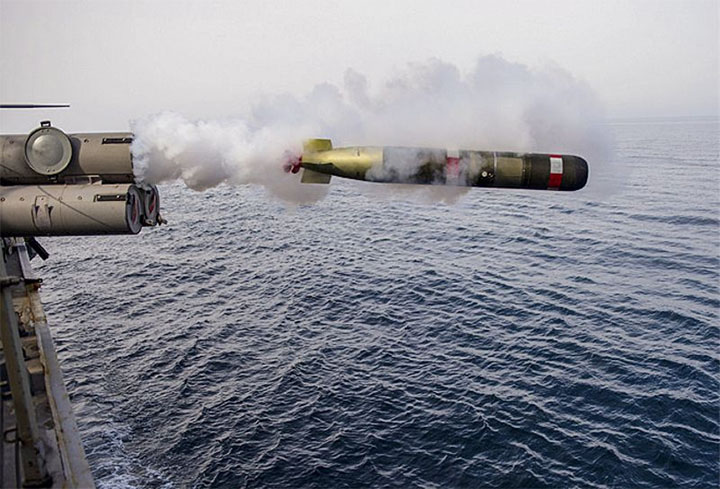
- It is a cigar-shaped, self-propelled underwater missile, launched from a submarine, surface vessel, or airplane and designed for exploding upon contact with the hulls of surface vessels and submarines.
- The MK 54 uses sophisticated processing algorithms to analyze the information, edit out false targets or countermeasures, and then pursue identified threats.
- The primary use of this equipment is for offensive purposes when deployed by anti-submarine warfare aircraft and helicopters, and for defensive purposes when deployed by ships and against fast, deep-diving nuclear submarines and slow-moving, quiet, diesel-electric submarines.
- India intends to use the Mk 54 torpedoes on its P-8I patrol aircraft.
- Expendables:
- Chaff:

- Chaff is a part of CounterMeasure Dispensing System (CMDS) is a passive expendable electronic counter measure used for protection of the naval ships from enemy's radar and missile seekers based on radio frequency.
- CMDS provides self-protection in sophisticated, diverse and dense threats to the aircraft against Radar guided & Infrared seeking missiles.
- It is composed of many small aluminium or zinc coated fibres stored on-board the aircraft in tubes.
- In case the aircraft feels threatened by any radar tracking missiles, chaff is ejected into the turbulent wake of air behind the plane.
- Chaff is a part of CounterMeasure Dispensing System (CMDS) is a passive expendable electronic counter measure used for protection of the naval ships from enemy's radar and missile seekers based on radio frequency.
- Flare:
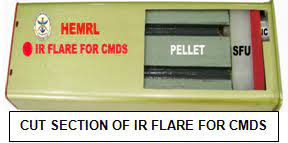
- A flare or decoy flare is also a part of CMDS, used by a plane or helicopter to counter an infrared homing ("heat-seeking") surface-to-air missile or air-to-air missile.
- Flares are commonly composed of a pyrotechnic composition based on magnesium or another hot-burning metal, with a burning temperature equal to or hotter than engine exhaust.
- The Infrared Flares are used to save the fighter and transport aircrafts from Infrared guided missiles (both surface to air and air to air threats).
- Flares on being fired provide an alternate strong IR (Infrared) source to heat-seeking anti-air missiles so that they are lured away from the aircraft.
- Chaff:
- Significance of the Deal:
- It will improve India’s capability to conduct anti-submarine warfare missions and serve “as a deterrent to regional threats and to strengthen [India’s] homeland defense”.
- It is part of the US commitment to share cutting-edge technology with India and to ensure that both nations enjoy the benefits of a secure and stable South Asia.
- It is significant in wake of the threat that China poses to both countries. In recent times, China has shown off its muscle power in the Indian Ocean, which can be seen as a threat to India.
- It is anticipated as America's way of warning China and trying to retain balance in the geopolitical context.
- In the recent past, the Quad collective, made up of India, Japan, Australia and the United States, had stated that they would do all they can to ensure peace in the Indo-Pacific region.
Queen Heo Hwang-ok
Why in News
Recently, on the banks of the Sarayu in Ayodhya, the Ram Katha Park has been renovated which will be renamed as Queen Heo Hwang-ok memorial park. The Korean queen is believed to have had Indian roots.
- In 2000, India and South Korea signed an agreement to develop Ayodhya and Gimhae as sister cities.
- Earlier, in March 2021 Indian Defence Minister and his South Korean counterpart inaugurated the India-Korea Friendship Park in a ceremony at the Delhi Cantonment.
Key Points
- About:
- She was a Korean queen who is believed to have been born Princess Suriratna of Ayodhya, daughter of King Padmasen and Indumati.
- Her story is described in Samguk Yusa (Memorabilia of Three Kingdoms).
- It is a 13th-century collection of legends, folktales and history of Korea’s three kingdoms — Goguryeo, Baekje and Silla — and some other regions.
- In 48 BC, the princess travelled to Korea from the ancient land of ‘Ayuta’ and married Kim Suro, founder and King of Geumgwan Gaya in south-eastern Korea.
- There is no consensus among historians on the location of 'Ayuta' as some historians believe that the princess could actually be from Thailand ’s Ayutthaya kingdom.
- While in the popular imagination, it is associated with Ayodhya in Uttar Pradesh, there is no Indian account of the legend.
- She was a Korean queen who is believed to have been born Princess Suriratna of Ayodhya, daughter of King Padmasen and Indumati.
- Princess Journey From India to Korea:
- She travelled by boat along with an entourage, having been sent by her father, who is said to have had a dream about her marrying king Suro.
- A pagoda, believed to have been brought by the queen from India to calm the ocean gods, is placed next to the tomb.
- According to the legend, the princess had taken a golden egg to Korea, and the park includes an egg made of granite.
Mahatma Gandhi National Fellowship: Phase II
Why in News
Recently, the government has launched the phase-II of Mahatma Gandhi National Fellowship under SANKALP (Skill Acquisition and Knowledge Awareness for Livelihood Promotion) programme.
SANKALP
- SANKALP, a Centrally sponsored scheme, is a World Bank loan assisted program, launched by the Ministry of Skill Development and Entrepreneurship in January 2018.
- SANKALP engages with District Skill Committees (DSCs) to effectively reduce the mismatch between the supply and demand of skilled manpower in the country, thereby creating decent opportunities for the youth to work and earn.
Key Points
- About:
- It is a two-year long fellowship programme conceived to create opportunities for young, dynamic individuals to contribute to enhancing skill development at the grassroots.
- MGNF Phase-I (Pilot): Launched in 2019 with IIM Bangalore as Academic Partner and 69 are Fellows currently deployed in 69 districts across 6 States.
- MGNF Phase-II (National Roll Out): Being launched in October 2021 with 661 MGNFs who will be deployed across all districts of the country. 8 more IIMs have been boarded taking the total to 9 IIMs.
- It seeks to combine classroom sessions by academic partner IIMs with an intensive field immersion at the district level to create credible plans and identify barriers in raising employment, economic output, and promote livelihoods in rural areas.
- The sharp focus on developing skills for local needs gives impetus to the "vocal for local", and also building an industry-relevant skill base will help the cause of "Atmanirbhar Bharat”.
- It is a two-year long fellowship programme conceived to create opportunities for young, dynamic individuals to contribute to enhancing skill development at the grassroots.
- Eligibility:
- Fellows have to be in the 21-30 years age-group, have a graduation degree from a recognized university and be citizens of India.
- Proficiency in official language of the state of fieldwork will be mandatory.
Other Schemes for Skill Development
- Pradhan Mantri Kaushal Vikas Yojana (PMKVY).
- Recognition of Prior Learning
- National Career Service Project
- Skill Management and Accreditation of Training Centres (SMART)
- Skills Strengthening for Industrial Value Enhancement (STRIVE)
- Pradhan Mantri YUVA Yojana (Yuva Udyamita Vikas Abhiyan)
- Kaushal Acharya Awards.
- Scheme for Higher Education Youth in Apprenticeship and Skills (SHREYAS).
- Atmanirbhar Skilled Employee Employer Mapping (ASEEM).
ADB Grants Loan for Mizoram
Why in News
Recently, the Indian government and the Asian Development Bank (ADB) signed a USD 4.5 million Project Readiness Financing (PRF) loan to support urban mobility in Mizoram.
- Earlier, the ADB and the Government of India signed a USD 484 million loan to improve transport connectivity and industrial development in the Chennai - Kanyakumari Industrial Corridor (CKIC) in Tamil Nadu.
- PRF supports high implementation readiness for projects that are expected to be financed by ADB.
Key Points
- About:
- Urban mobility in Aizawl, the center of Mizoram’s administrative and service industry, is severely constrained due to rapid and unplanned urbanization.
- This results in traffic congestion on narrow road widths, and adversely impacts road safety, efficiency in movement of people and goods, and environmental sustainability.
- The ensuing project, being developed through the project readiness financing, seeks to resolve the city’s transport problems by adopting sustainable urban mobility solutions.
- It will help develop institutional capacity of the state’s Urban Development and Poverty Alleviation Department in pre-implementation and project preparation activities.
- The PRF will develop a Comprehensive Mobility Plan (CMP) for Aizawl that outlines the urban transport development strategy and build synergies with urban development planning initiatives in the state, and promote climate and disaster resilience, and gender inclusiveness in its interventions.
- CMP will facilitate an optimised use of capital in relevant projects, and enhance the economic competitiveness of cities by improving logistics and access to jobs, basic services, education, etc.
- Urban mobility in Aizawl, the center of Mizoram’s administrative and service industry, is severely constrained due to rapid and unplanned urbanization.
- Asian Development Bank:
- It is a regional development bank established on 19th December 1966. It is headquartered in Manila, Philippines.
- It now has 68 members, 49 from within Asia.
- India is one of the members.
- It’s five largest shareholders are Japan and the United States (each with 15.6% of total shares), the People’s Republic of China (6.4%), India (6.3%), and Australia (5.8%).
- It aims to promote social and economic development in Asia and the Pacific.
- Asian Development Outlook (ADO) is a series of annual economic reports on the Developing Member Countries (DMCs) of the Asian Development Bank (ADB).
New Medicine for Bovine Mastitis
Why in News
Recently, the National Innovation Foundation (NIF) has developed a poly-herbal medicine called Mastirak Gel to treat Mastitis in Dairy Cattle.
- NIF is an autonomous institute of the Department of Science and Technology (DST), which renovates indigenous technologies based on farmer’s wisdom.
Key Points
- Significance of Mastirak Gel:
- It can improve the udder (Milk producing part) health.
- It reduces inflammation which is detrimental to the udder.
- It also reduces the use of antibiotics and helps in the cost-effective management of the disease.
- Treatment of infected animals with antibiotics poses a public health hazard.
- Mastitis
- About:
- Mastitis, or inflammation of the mammary gland, is the most common and the most expensive disease of dairy cattle throughout most of the world.
- Several types of bacteria cause distinctly different mastitis infections.
- Antibiotic infusions into the udder nearly always cure the clinical disease but may not eliminate the bacterial infection.
- Mastitis, or inflammation of the mammary gland, is the most common and the most expensive disease of dairy cattle throughout most of the world.
- Cause:
- Prevention:
- New infections are prevented by focusing management efforts on reducing the presence of pathogens on the teat end.
- The single most important management practice to prevent transmission of new infections is the use of an effective germicide as a post milking teat dip.
- Impact:
- It can affect farm productivity due to fall in milk quality, thus impacting income-generating activities.
- It reduces milk yields, increases the cost of production and makes milk less valuable for liquid consumption and manufacture.
- About:

